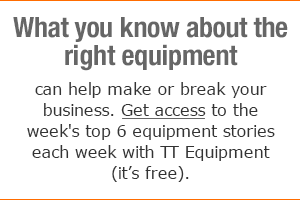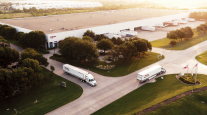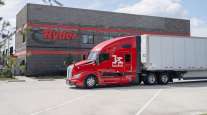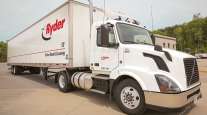Contributing Writer
Mobile Lifts Gaining Momentum in Service Shops
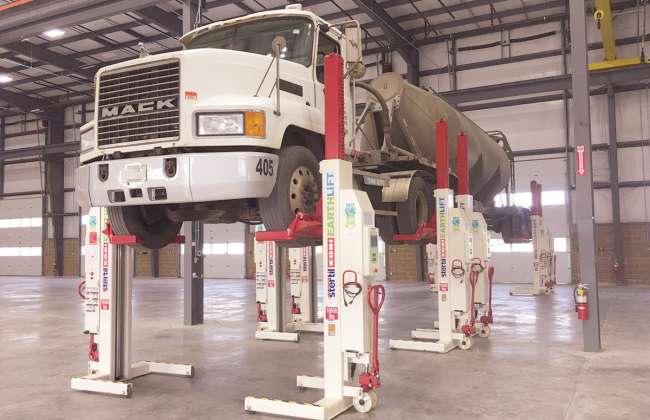
To do their jobs, fleet maintenance technicians need to get underneath 17,000-pound semi-tractors. But how do they do it?
Ryder System Inc.’s answer is to lift the tractor using mobile columns, a method adopted by an increasing number of heavy-duty fleets.
Maverick USA Inc., on the other hand, is among those that use old-fashioned jacks and have their technicians roll underneath the tractor using creepers.
So why the different approaches?
Chris Marks, director of maintenance for Miami-based Ryder, said the time savings from the lifts justify their cost.
“When we’re doing a clutch or a transmission, it’s pretty close to half the labor to pull that transmission out [compared with] if you’re laying on a creeper,” he said. “When you’re doing preventive maintenance, just having the ability to visually look at things [where] before you were using a flashlight laying on a creeper or looking for a frame rail — that makes it that much better, too.”
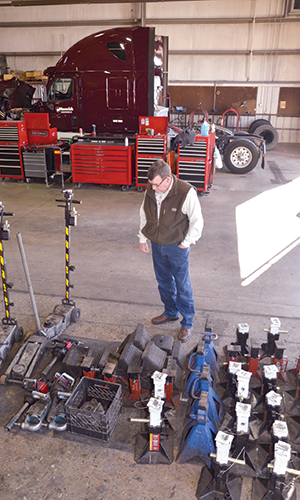
Air jacks and jack stands have proved themselves over time, Maverick USA Maintenance Diretor Hilton said. (Steve Brawner)
However, Brent Hilton, director of maintenance at North Little Rock, Ark.-based Maverick, said air jacks and jack stands have “proven themselves over time” with his fleet of 1,600 trucks.
“We’ve looked at (lift) technology, and it looks good, but it’s very expensive, and you’ve really got to look at all your aspects of how that’s going to affect your shop flow,” he said. “You put up one of those huge systems in here, and it takes up a lot of room.”
Hilton said most maintenance now occurs above the truck, so moving to a lift system isn’t worth the cost — at least not yet. But the fleet is looking at lifts because trucks are built so low to the ground for aerodynamic reasons that it’s becoming harder to get underneath them with a creeper.
Ryder’s Supply Chain Solutions unit and Maverick USA rank Nos. 13 and 80, respectively, on the Transport Topics Top 100 list of the largest for-hire carriers in North America.
If Maverick does move from jacks to lifts, the fleet will have numerous types from which to choose.
There are lots of ways to get a truck up in the air, but mobile columns have gained momentum in the trucking industry.
According to Peter Bowers, Stertil-Koni’s technical sales support manager, mobile columns are the company’s biggest seller and, in the heavy-duty arena, are now the dominant lifting system.
Todd Michalski, vice president of sales and marketing at Gray Manufacturing Co., which designs and manufactures lifting equipment, said he has been with the company 10 years, and it’s probably selling eight times as many mobile lifts as when he arrived.
Doug Spiller, product manager for heavy-duty lifting at Rotary Lift, said mobile columns have become the leader in the Class 8 segment.
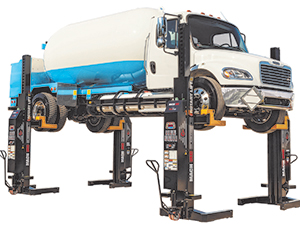
Rotary Lift
Manufacturers point to several reasons for mobile columns’ increased use.
In addition to their flexibility and mobility, they give technicians access to the entire driveline by lifting the vehicle by the wheels. Mobile lifts allow technicians to raise one vehicle, place it on a jack stand and then move the lifts to another truck. They can adjust to any wheelbase: semi-tractors, smaller trucks or ATVs.
Ryder began using ARI-Hetra mobile lifts about 10 years ago and now rarely, if ever, buys another kind. The company tries to keep one set per shop where the roof is high enough to allow it. Marks said at first there was some pushback from technicians who had to grow accustomed to standing under a truck, but he’s convinced that lifts are safe, and now, so are they.
“There’s less bumping their heads and busting their knuckles when they’re standing up and they can see what they’re working on,” he said.
The market for all lifts, including mobile columns, is competitive, and the manufacturers each offer their own accessories, innovations and selling points.
Rotary Lift’s Spiller points to his company’s MachFlex remote control that enables the operator to be mobile rather than stand at a single column. Stertil-Koni’s Bowers notes that his company’s columns have locks that are only 1.375 inches apart, reducing the drop distance that would occur if there were slippage. The company’s EarthLift products feature recyclable batteries that recharge on the down cycle, extending the time between recharges.
Steve Perlstein, president of Mohawk Lifts, said his company offers double-wide columns for tandem lifting. The Mohawk mobile column also has retractable wheels and works on a 3-degree sloped floor, which he said is advantageous in shops that aren’t completely flat. The lifting forks on his mobile lift are long enough to reach beneath both tires as well as a super single without creating a bulge, Perlstein said.
Among the biggest technological innovations in recent years has been wireless communication between the columns. Paul Feldman, director of marketing at Stertil-Koni, said cables can be damaged and also are a tripping hazard, and for that reason, “wireless is the product of choice.”
The biggest change moving forward will be computers embedded in the lift for shop functions such as work orders, ordering parts and diagnostics, said Gray Manufacturing’s Michalski. His company recently won a patent for placing diagnostic software on the columns so another computer won’t be needed in the bay.
Michalski said the lift’s technology revolves around safety. “The computers now are controlling the lifting versus what the mechanic can do, so it just keeps them from getting the vehicle in trouble,” he said.
While mobile columns have gained acceptance, stationary lifts such as four-post and platform lifts still have their place.
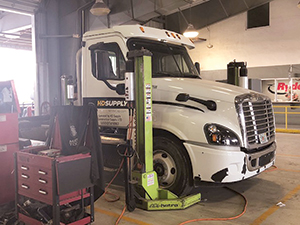
Truck in Ryder shop shown with ARI-Hetra mobile lifts. Ryder says it is using mobile lifts almost exclusively. (Ryder System Inc.)
Stertil-Koni’s “continuous recess” system on its DiamondLift and EcoLift products allows the technicians to increase or decrease the spread, making it easier to work on a variety of vehicle sizes. The lifts travel fully retracted along a track that is flush with the floor.
One advantage of four-post lifts is speed, Perlstein said. His company sells a variety of products, including one capable of lifting 120,000 pounds.
“You drive the vehicle on, you hit the up button, and 60 seconds later you’re spinning wrenches,” he said, adding there are no mobile column lifts that are as fast as the drive-on, four-post lift “because they all have to get set up, positioned, sometimes turned on and initiated, and the initiation process can be sometimes challenging.”
The lifts last a long time. Feldman said there’s not much of a secondary market because “the people expire before the lifts do.” Still, Bowers said there’s plenty of opportunity in the marketplace because fleets are using dated lifting equipment.
R.W. “Bob” O’Gorman, president of the Automotive Lift Institute, said the most important trends from his perspective are safety and education. ALI is the industry’s third-party watchdog that certifies lifts with its gold label.
O’Gorman said carriers should buy only ALI-certified lifts in what is “a buyer-beware environment.”
It’s legal to sell lifts in North America that don’t meet industry safety and performance standards, but installing them often can violate the International Building Code and state and local regulations. O’Gorman said the lifts industry is still beset by product dumping — mostly in the hobby and home markets but also in the commercial market.
The ALI gold label is the only proof that a model has been tested and meets safety requirements. Products labeled “CE,” which means it was tested in Europe, or “China national certification” have not met North American standards. Unlike some consumer goods certifications or most European schemes, the ALI certification process does not allow for a producer to perform its own tests.
Whatever the new technology, stakeholders, code enforcers and others involved in safety must work with the manufacturer and “consider each possible use … be it intended by the manufacturer or not,” he said. That means anticipating not only how a new technology will be used but also the ways it could be misused on the job site.
“Your employees will be standing under these lifts,” O’Gorman said. “Do you really want to trust their safety to a product that has not been certified to meet the safety standards?”


